Oct. inflation likely hit 7.2% — poll

By Keisha B. Ta-asan, Reporter
INFLATION likely quickened beyond 7% in October amid surging food prices and broadening second-round effects, analysts said.
A BusinessWorld poll of 14 analysts conducted last week yielded a median estimate of 7.2% for the consumer price index (CPI) in October.
If realized, October inflation would be faster than the 6.9% seen in September and the 4% last year. It would also be the quickest pace in over 14 years or since the 7.8% in December 2008 at the height of the global financial crisis.
This would also mark the seventh straight month that inflation breached the central bank’s 2-4% target band.
The Bangko Sentral ng Pilipinas (BSP) is scheduled to release its inflation forecast range for the month today (Oct. 31). The Philippine Statistics Authority will release the official inflation data on Nov. 4.
Analysts noted that food prices, particularly meat, fish, and vegetables, continued to rise as a result of supply shortages caused by typhoons this month.
“For October inflation, I’m looking at 7%, driven by food prices as the recent typhoon Karding and current rain conditions have seen some supply tightness in food and food logistics challenges,” Sun Life Investment Management and Trust Co. economist Patrick M. Ella said in an e-mail.
Agricultural damage due to Super Typhoon Karding (international name: Noru) reached P3.12 billion, while damage due to Tropical Depression Maymay and Typhoon Neneng stood at P594.02 million.
“Storm damage recently could have led to some temporary increase in the prices of food and other agricultural commodities, as well as on overall inflation, until supply chains normalize,” Rizal Commercial Banking Corp. Chief Economist Michael L. Ricafort said.
ING Bank N.V. Manila Senior Economist Nicholas Antonio T. Mapa said the follow-through price increase for food items likely pushed inflation beyond 7% in October.
“Transport fare adjustment also kicked in by October while pump prices increased for two weeks after successive price drops. We expect inflation to peak in November then only gradually decelerate going into 2023,” Mr. Mapa added.
Traditional and modern jeepneys recently raised the minimum fares to P12 and P14, respectively. Ordinary passenger buses also hiked the minimum fare to P13.
In October alone, oil companies increased pump prices for gasoline by P0.50 per liter, diesel by P8 per liter, and kerosene by P4.25 per liter, data from the Energy department showed.
ANZ Research economist Debalika Sarkar said in an e-mail that lower electricity rates may have provided partial relief for consumers.
Manila Electric Co. lowered the overall electricity rate by P0.0737 per kilowatt-hour (kWh) to P9.8628 in October.
Also, the continued weakness of the peso may have fueled inflation as it made imports more expensive, Colegio de San Juan de Letran Graduate School Associate Professor Emmanuel J. Lopez said.
“In our view, the pace of inflation will continue since the second-round impact of the global commodities increases and impact of the depreciating value of the peso against the US dollar will likely still be felt in the near term,” Philippine National Bank economist Alvin Joseph A. Arogo likewise said.
The peso traded around P58 to P59 per dollar this month. It went back to the P57 level when it closed at P57.97 on Friday.
In October alone, the peso has strengthened by P0.655 or 1.13% from its Sept. 30 close of P58.625.
“Basic commodities prices also followed the upward trend in anticipation of the holiday season,” Mitzie Irene P. Conchada, an economist from De La Salle University, said.
IS THE PEAK NEAR?China Banking Corp. Chief Economist Domini S. Velasquez said inflation may likely peak this month.
“Key risks would include the inability of the government to address current and potential shortages and possible increase in electricity rates. The proposed increase in water tariffs next year might push up 2023 average inflation above the high-end target of BSP after averaging by an estimated 5.6% this year,” Ms. Velasquez said.
Manila Water Co., Inc. has proposed a rate increase of P20 per cubic meter from 2023 to 2027.
“Although it seems like inflation is approaching its peak, it is still a long way from gravitating back into the official 2-4% target range,” ANZ Research’s Ms. Sarkar said.
Noting the strong domestic demand and volatility in the foreign exchange market, Ms. Sarkar said she expects the BSP to continue hiking rates until the second quarter of 2023.
“Our 2022 and 2023 year-end policy rate forecasts are 4.75% and 5.25%, respectively,” she added.
The Monetary Board has so far raised 225 basis points (bps) to 4.25% since May.
“BSP has communicated clearly that it would like to match Fed point by point. Given our outlook for a 75-bp rate hike by the Fed in November and a 50-75 bp rate hike in December, expect that BSP can raise rates to 5.5-5.75% by yearend,” ING’s Mr. Mapa said.
BSP Governor Felipe M. Medalla said last week the BSP may have to respond to the US Federal Reserve point by point to tame inflation and slow down the peso’s depreciation.
He said the Monetary Board may hike by 75 bps at its next rate-setting meeting on Nov. 17 if the US central bank delivers its fourth 75-bp rate increase on Nov. 1-2.




